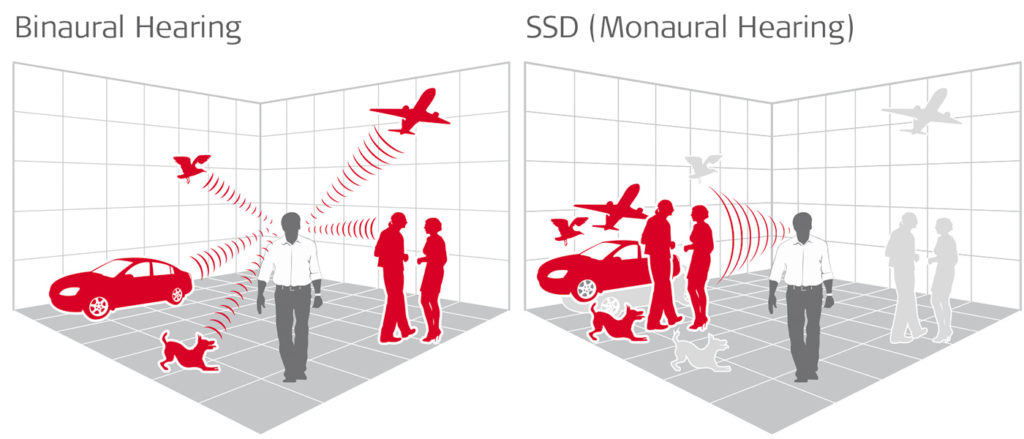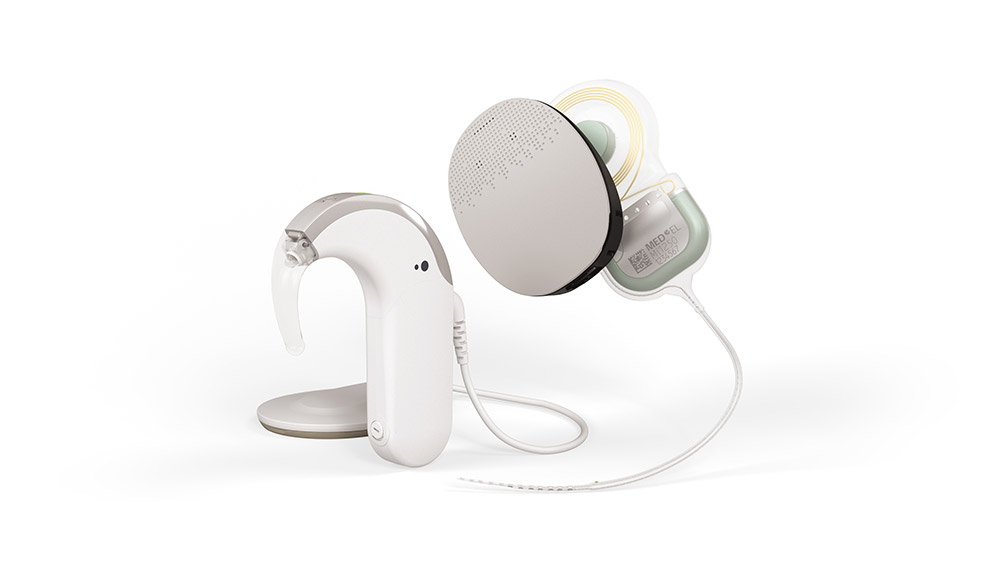The beauty of hearing with both ears
Hearing is better with two ears than with one. We speak of bimodal hearing when different hearing devices are used on each side.

Hearing on both sides enables spatial sound perception and acoustic spatial orientation, clearer sound perception near the hearing threshold and better understanding of speech in loud – all of that with simultaneously more relaxed hearing. Not all Cochlear Implant users are completely deaf on both sides, many use a hearing aid on the other ear. The better the hearing is reproduced with the hearing aid, the greater is the benefit if bimodality. The hearing aid and the cochlear implant have to interact optimally to achieve all-round better hearing outcomes for bimodal users.
Even if the two systems are fundamentally compatible, differing signal processing can significantly affect hearing quality. Therefore, the Cochlear Implant system should imitate as closely as possible natural hearing and the sound processing in the Cochlear Implant and the sound processing in the Cochlear Implant should match that in the hearing aid.

Binaural hearing delivers a more natural and richer hearing impression to CI users with single-sided deafness, bilaterally implanted CI users and bimodal recipients using hearing aid and CI.
Bimodal with hearing aids of all types and brands
An increasing number of brand-specific bimodal solutions have been touted in recent times: the functions of a hearing aid are usually matched to the audio processor from the same manufacturing group.
The consideration of the contralateral Cochlear Implant then does not leave the necessary freedom to optimise the hearing aid individually. On the other hand, this practice binds the bimodally-fitted user exclusively to one brand of hearing aid throughout the lifetime of the implant. The search for a suitable hearing aid and optimal setting can take several years in individual cases – giving up a once-optimal solution in favour of a reconciliation with the Cochlear Implant means noticeable losses of hearing for those affected.
As MED-EL imitates the hearing organs closely to nature with its Cochlear Implant systems, unilateral Cochlear Implant users can also continue to use a hearing aid that they are already used to in the other ear together with the Cochlear Implant- even with the usual settings. If a new hearing aid is needed later, the user can choose from all the hearing aids currently offered.
At the right volume
Healthy human ears are about three times more sensitive to quiet sounds than to loud ones. This amplification function is lost where there is an inner ear hearing loss and is imitated by modern hearing aids. Cochlear Implant audio processors amplify quiet sounds, where the Cochlear Implant manufacturers follow different philosophies.
The so-called Dual-Loop Automatic Gain Control was designed in MED-EL audio processors to imitate the natural function as closely as possible. It can also be individually adjusted, including to the volume properties of a hearing aid on the other ear. A volume conciliation between the Cochlear Implant and the hearing aid is normally the only necessary step so that nearly any hearing aid can be combined with a MED-EL Cochlear Implant without difficulty. The hearing aid can remain set so that it offers optimum hearing impression on the non-implanted side independently of the Cochlear Implant.
Stimulated at the right place
High notes are perceived at the entrance to the coil in the cochlea and lower notes at the end. In the cochlear implantation, the surgeon feeds an electrode into the non-functioning hearing coil. The electrode then gives off electrical impulses which are passed on via the auditory nerve to the brain and interpreted there.
Long electrodes cover the whole length of the cochlea enabling stimulation precisely where the note is naturally heard. MED-EL brought these long electrodes onto the market as long ago as 1994 and is still today the only manufacturer offering these long electrodes. In combination with the also unique fine structure coding, MED-EL thereby enables excellent pitch impression, especially similar to that with natural hearing or with a hearing aid.
Stimulated at the right time
In the natural hearing process, a so-called travelling wave is set up in the cochlea which spreads from the oval window to the tip of the coil. In connection with the frequency distribution in the cochlea, this brings about a delay of around three milliseconds for deep sounds. This delay is replicated in MED-EL audio processors.
Hearing aids need additional time to process the sound so that speech can be optimally understood. The user does not usually notice the few milliseconds. If the delay only affects one side of binaural users, it could be misinterpreted by the central hearing: the benefits of bilateral hearing would be restricted. The current MED-EL Cochlear Implant audio processors can also synchronise their processing chronologically with the hearing aid. This function is unique to MED-EL.

Hear everything well on both sides
It is important to many Cochlear Implant users that they can connect their hearing systems to external hearing sources. That is possible simply via standardised contacts and without additionally being bound to certain manufacturers and brands. Bluetooth induction loops allow this kind of standardised contact between the hearing system and audio source: wireless streaming to smartphone or tablet, TV or other Bluetooth compatible sound sources, inductive contact to the hearing system.
Combination of an excellent Cochlear Implant with the hearing aid that is best suited to each user is crucial for bimodal hearing. Nearly natural sound processing and unique functions enable the combination of MED-EL Cochlear Implants with every brand of hearing aid currently on the market and ideal complementarity.






